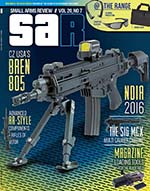Book Reviews: V20N7
By Dean Roxby
American Thunder 3rd Edition
Frank Iannamico
Copyright 2000, 2004, 2015
The name Frank Iannamico will be very familiar to SAR readers. Mr. Iannamico has written many articles for SAR over the last 20 years. He also has written or co-written a large number of books on military small arms. Several of these titles have been updated with second and third editions.
American Thunder is the latest such title. This fine book covers the Thompson submachine gun in all its military variations. Although it does not attempt to document all the civilian and Law Enforcement versions, it does touch on those to some degree as well.
The author notes that most Thompson SMG writings cover the early Colt produced Model 1921. This book deals with the far greater numbers of military M1928, and M1 versions. As a comparison, there were only 15,000 Model 1921 guns built by Colt in just less than one year. The M1928, M1928A1, M1, and M1A1 models totalled well over one million guns by the end of production in 1944.
The book starts by looking back to the evolution of the submachine gun, and a brief look at some of the early guns from around the world. The Italian Villar Perosa dates from 1915, and is regarded as the first of the type. The German MP18.i also made an appearance at the end of WWI. Both of these are shown in color photographs.
It was towards the end of WWI that John T. Thompson formed the Auto-Ordnance Corporation, initially to develop a new semi-automatic rifle for the military. Although the AOC Auto-Rifle did not get accepted, the company continued on. At this point, Thompson and his team turned to developing a submachine gun that would eventually become the famous Tommy gun.
The book follows the story of the early years of Thompson and his team at AOC. People as well as prototype guns are covered, giving an interesting background to the development program. Many B&W photos from the era are shown, as well as early typewritten letters that give an insight to the history of the program.
Many clear crisp color photos show the evolution of the various models through the years. Both overall views and close-up detail photos help the reader to appreciate the differences between the models.
The author has accessed many company documents from the time, including those detailing prices. A new Thompson for $225 sounds ridiculous now, but that was a LOT of money in the Great Depression of the 1930’s.
Besides US military usage, other allied countries use is documented. Great Britain was an early adopter of the Tommy gun, and other Commonwealth countries followed. British, Canadian, and Australian property marks are detailed. The Lend-Lease program is mentioned, and several wonderful color photos of crates full of Lend-Lease guns sent to the USSR are shown. Many of these guns are unissued! The stuff dreams are made of… It is interesting to note that European deactivation laws differ from US law, and some former Soviet Lend-Lease guns are now being sold to European collectors.
The book does a very nice job of explaining the simplifying of production during WWII. Many small changes were made to speed up the machining required. It was this thinking that led to the newer M1/M1A1 replacing the older and more complicated M1928/M1928A1 types.
Separate chapters detailing drums, magazines, pouches, and other accoutrements help the collector. Most of these items are from a few serious collectors that allowed their fine collections to be photographed.
Chapter XIII Experiments, Prototypes, and Foreign Copies is an interesting section. Straight-line stocks, Aluminum receiver versions, and copies made in Turkey and China are noted. The Turkish made gun featured a brass receiver. The following chapter follows the move to replace the Thompson with a cheaper simpler design. This eventually led to the M3 “grease gun”.
Featuring many intriguing company and War Dept documents, B&W photos from WWII and prior, and numerous high quality color photos, all printed on quality glossy paper, this book will make a great addition to your reference library.
This article first appeared in Small Arms Review V20N7 (September 2016) |
| SUBSCRIBER COMMENT AREA |
Comments have not been generated for this article.




